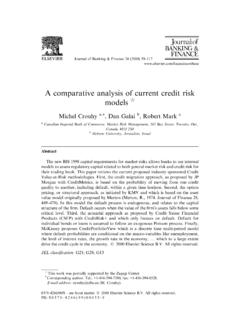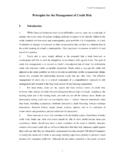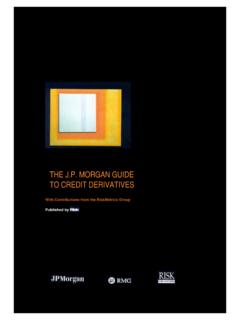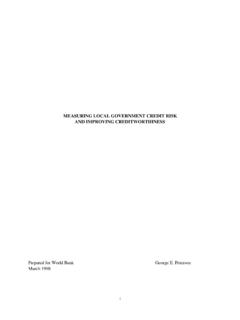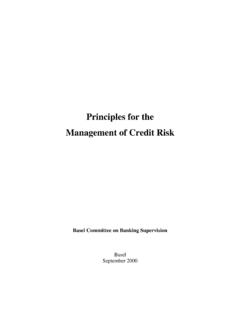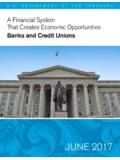Transcription of Credit risk rating systems at large US banks q
1 Journal of Banking & Finance 24 (2000) 167 201. Credit risk rating systems at large US banks q William F. Treacy, Mark Carey *. Federal Reserve Board, Washington, DC 20551, USA. Abstract Internal Credit risk rating systems are becoming an increasingly important element of large commercial banks measurement and management of the Credit risk of both in- dividual exposures and portfolios. This article describes the internal rating systems presently in use at the 50 largest US banking organizations. We use the diversity of current practice to illuminate the relationships between uses of ratings , di erent options for rating system design, and the e ectiveness of internal rating systems . Growing stresses on rating systems make an understanding of such relationships important for both banks and regulators. 2000 Published by Elsevier Science All rights re- served.
2 JEL classi cation: G20; G21. Keywords: ratings ; Credit risk; Risk management; bank risk 1. Introduction Internal Credit ratings are an increasingly important element of Credit risk management at large US banks . Their Credit -related businesses have become progressively more diverse and complex and the number of their counterparties has grown rapidly, straining the limits of traditional methods of controlling q The views expressed herein are the authors' and do not necessarily re ect those of the Board of Governors or the Federal Reserve system . *. Corresponding author. Tel.: +1-202-452-2784; fax: +1-202-452-5295. E-mail address: (M. Carey). 0378-4266/00/$ - see front matter 2000 Published by Elsevier Science All rights reserved. PII: S 0 3 7 8 - 4 2 6 6 ( 9 9 ) 0 0 0 5 6 - 4. 168 Treacy, M. Carey / Journal of Banking & Finance 24 (2000) 167 201.
3 And managing Credit risk. In response, many large banks have introduced more structured or formal systems for approving loans, portfolio monitoring and management reporting, analysis of the adequacy of loan loss reserves or cap- ital, and pro tability and loan pricing analysis. Internal ratings are crucial inputs to all such systems as well as to quantitative portfolio Credit risk models. Like a public Credit rating produced by agencies such as Moody s or Standard & Poor s, a bank s internal rating summarizes the risk of loss due to failure by a given borrower to pay as promised. However, banks rating systems di er signi cantly from those of the agencies, partly because internal ratings are assigned by bank personnel and are usually not revealed to outsiders. This article describes the internal rating systems presently in use at the 50.
4 Largest US banking organizations. We use the diversity of current practice to illuminate the relationships between uses of ratings , di erent options for rating system design, and the e ectiveness of internal rating systems . An understanding of such relationships is useful to banks , regulators, and researchers. Such understanding can help banks manage transitions to more complex and demanding uses of ratings in risk management. US regulatory agencies already use internal ratings in supervision. Moreover, the Basle Committee is beginning to consider proposals to make international bank capital standards more sensitive to di erences in portfolio Credit risk, and in- ternal ratings play a key role in several such proposals, two of which are sketched by Mingo (2000). Regulatory reliance on internal ratings would in- troduce new and powerful stresses on banks internal rating systems which, if not addressed, could disrupt Credit risk management at many banks .
5 The speci cs of internal rating systems currently di er across banks . The number of grades and the risk associated with each grade vary, as do decisions about who assigns ratings and about the manner in which rating assignments are reviewed. To a considerable extent, such variations are an example of form following function. banks in di erent lines of business or using internal ratings for di erent purposes design and operate di erent systems that meet their needs. For example, a bank that uses ratings mainly to identify deteriorating or problem loans to ensure proper monitoring may nd that a rating scale with relatively few grades is adequate, whereas a bank using ratings in computing the relative pro tability of di erent loans may require a scale with many grades in order to achieve ne distinctions of Credit risk.
6 As described by Altman and Saunders (1997), much research on statistical models of debt default and loss has been published over the past few decades. Many banks use statistical models as an element of the rating process, but rating assignment and review almost always involve the exercise of human judgment. Because the factors considered in assigning a rating and the weight given each factor can di er signi cantly across borrowers, banks (like the rating agencies) generally believe that the current limitations of statistical models are such that properly managed judgmental rating systems deliver more Treacy, M. Carey / Journal of Banking & Finance 24 (2000) 167 201 169. accurate estimates of risk. Especially for large exposures, the bene ts of such accuracy may outweigh the higher costs of judgmental systems , and banks typically produce internal ratings only for business and institutional loans and counterparties.
7 1 In contrast, statistical Credit scores are often the primary basis for Credit decisions for small exposures, such as consumer Credit . 2. Given the substantial role of judgment, potentially con icting sta incen- tives are an important consideration in rating system design and operation. In the absence of e ective internal rating review and control systems , rating as- signments may be biased. The direction of such bias tends to be related to a bank s uses of ratings in managing risk. For example, at banks that use ratings in computing risk-adjusted pro tability measures or pricing guidelines, the sta . may be tempted to assign ratings that are more favorable than warranted. Most banks rely heavily on loan review departments and informal disciplines associated with corporate culture to control incentive con icts. Although form generally follows function, rating system design and oper- ation is a complex task, involving considerations of cost, e ciency of infor- mation gathering, consistency of ratings produced, and sta incentives, as well as the uses to which ratings are put.
8 Changes in a bank s business and its uses of ratings can cause form and function to diverge, placing stresses on its rating systems that are neither anticipated nor immediately recognized. Failure to relieve severe stresses can compromise the e ectiveness of a bank s Credit risk management. Outlined below are a number of recommended practices for both banks and regulators. Such practices can help limit stresses and can improve the operation and exibility of internal rating systems . This article is based on information from internal reports and Credit policy documents for the fty largest US bank holding companies, from interviews with senior bankers and others at more than 15 major holding companies and other relevant institutions, and from conversations with Federal Reserve bank examiners. The institutions we interviewed cover the spectrum of size and practice among the fty largest banks , but a disproportionate share 1.
9 Credit risk can arise from a loan already extended, loan commitments that have not yet been drawn, letters of Credit , or obligations under other contracts such as nancial derivatives. We follow industry usage by referring to individual loans or commitments as ``facilities'' and overall Credit risk arising from such transactions as ``exposure''. Throughout this article, we ignore issues of ``loan equivalency'', that is, the fact that some portion of the unfunded portion of a commitment is exposed to loss because the borrower may draw on the commitment prior to default. 2. At most large banks , internally rated assets include commercial and industrial loans and facilities, commercial leases, commercial real estate loans, loans to foreign commercial and sovereign entities, loans and other facilities to nancial institutions, and sometimes large loans to individuals made by ``private banking'' units.
10 In general, ratings are produced for exposures for which underwriting requires large elements of subjective analysis. 170 Treacy, M. Carey / Journal of Banking & Finance 24 (2000) 167 201. of the banks we interviewed have relatively advanced internal rating systems . 3. Although a large literature has examined public rating agency procedures and the properties of their ratings (see Cantor and Packer, 1994; Ederington and Yawitz, 1987; Altman and Saunders, 1997; and references therein), this article is the rst to provide a detailed analysis of internal Credit risk rating systems . 4 Udell (1987,1989) examined the internal rating systems of a sample of Midwestern US banks as part of a broader study of such banks loan review systems . Brady et al. (1998) and English and Nelson (1998) o er some infor- mation about the internal rating scales of a sample of US banks of all sizes and also report both distributions of loans across grades and relationships between grades and loan pricing for a strati ed sample of banks .
